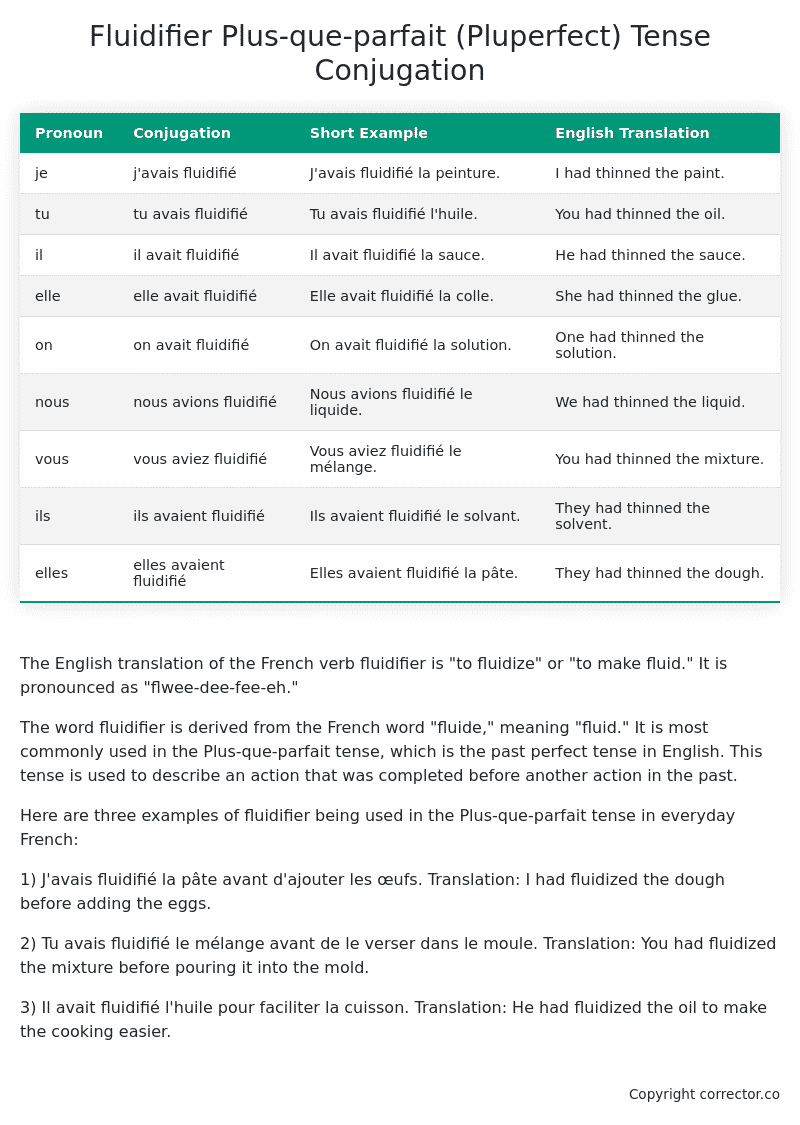Plus-que-parfait (Pluperfect) Tense Conjugation of the French Verb fluidifier
Introduction to the verb fluidifier
The English translation of the French verb fluidifier is “to fluidize” or “to make fluid.” It is pronounced as “flwee-dee-fee-eh.”
The word fluidifier is derived from the French word “fluide,” meaning “fluid.” It is most commonly used in the Plus-que-parfait tense, which is the past perfect tense in English. This tense is used to describe an action that was completed before another action in the past.
Here are three examples of fluidifier being used in the Plus-que-parfait tense in everyday French:
1) J’avais fluidifié la pâte avant d’ajouter les œufs.
Translation: I had fluidized the dough before adding the eggs.
2) Tu avais fluidifié le mélange avant de le verser dans le moule.
Translation: You had fluidized the mixture before pouring it into the mold.
3) Il avait fluidifié l’huile pour faciliter la cuisson.
Translation: He had fluidized the oil to make the cooking easier.
Table of the Plus-que-parfait (Pluperfect) Tense Conjugation of fluidifier
| Pronoun | Conjugation | Short Example | English Translation |
|---|---|---|---|
| je | j’avais fluidifié | J’avais fluidifié la peinture. | I had thinned the paint. |
| tu | tu avais fluidifié | Tu avais fluidifié l’huile. | You had thinned the oil. |
| il | il avait fluidifié | Il avait fluidifié la sauce. | He had thinned the sauce. |
| elle | elle avait fluidifié | Elle avait fluidifié la colle. | She had thinned the glue. |
| on | on avait fluidifié | On avait fluidifié la solution. | One had thinned the solution. |
| nous | nous avions fluidifié | Nous avions fluidifié le liquide. | We had thinned the liquid. |
| vous | vous aviez fluidifié | Vous aviez fluidifié le mélange. | You had thinned the mixture. |
| ils | ils avaient fluidifié | Ils avaient fluidifié le solvant. | They had thinned the solvent. |
| elles | elles avaient fluidifié | Elles avaient fluidifié la pâte. | They had thinned the dough. |
Other Conjugations for Fluidifier.
Le Present (Present Tense) Conjugation of the French Verb fluidifier
Imparfait (Imperfect) Tense Conjugation of the French Verb fluidifier
Passé Simple (Simple Past) Tense Conjugation of the French Verb fluidifier
Passé Composé (Present Perfect) Tense Conjugation of the French Verb fluidifier
Futur Simple (Simple Future) Tense Conjugation of the French Verb fluidifier
Futur Proche (Near Future) Tense Conjugation of the French Verb fluidifier
Plus-que-parfait (Pluperfect) Tense Conjugation of the French Verb fluidifier (this article)
Passé Antérieur (Past Anterior) Tense Conjugation of the French Verb fluidifier
Futur Antérieur (Future Anterior) Tense Conjugation of the French Verb fluidifier
Subjonctif Présent (Subjunctive Present) Tense Conjugation of the French Verb fluidifier
Subjonctif Passé (Subjunctive Past) Tense Conjugation of the French Verb fluidifier
Subjonctif Imparfait (Subjunctive Imperfect) Tense Conjugation of the French Verb fluidifier
Subjonctif Plus-que-parfait (Subjunctive Pluperfect) Tense Conjugation of the French Verb fluidifier
Conditionnel Présent (Conditional Present) Tense Conjugation of the French Verb fluidifier
Conditionnel Passé (Conditional Past) Tense Conjugation of the French Verb fluidifier
L’impératif Présent (Imperative Present) Tense Conjugation of the French Verb fluidifier
L’infinitif Présent (Infinitive Present) Tense Conjugation of the French Verb fluidifier
Struggling with French verbs or the language in general? Why not use our free French Grammar Checker – no registration required!
Get a FREE Download Study Sheet of this Conjugation 🔥
Simply right click the image below, click “save image” and get your free reference for the fluidifier Plus-que-parfait tense conjugation!

Fluidifier – About the French Plus-que-parfait (Pluperfect) Tense
Tense Formation
Common everyday usage patterns
Sequencing of past events
Background information
Hypothetical or reported speech
Interactions with other tenses
Summary
I hope you enjoyed this article on the verb fluidifier. Still in a learning mood? Check out another TOTALLY random French verb conjugation!


